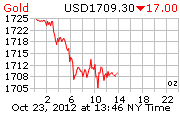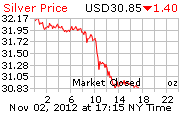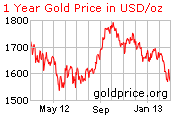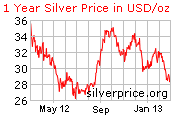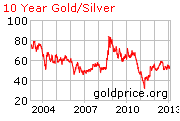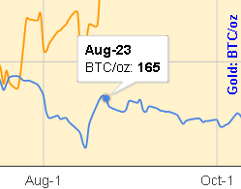Archive
Continuous Commodity Index at its all-time high. How do Political Metals compare?
Today’s post is all about charts - Continuous Commodity Index (CCI) & Relative performance, Gold/Silver ratios, etc.
The CCI, comprising 17 commodities, is a widely recognized barometer of commodity prices. The rapidly expanding money supply (see earlier posts here & here) as a result of money printing operations QE1 & QE2 has found it’s way into the commodities market. It is at it’s all time high, surpassing the previous peak just prior to the 2008 crash.
The second chart below illustrates how price increases in these 17 commodities compared with other asset classes over 1 year (as at 1 Feb 2011). It should concern everyone that most of the major essential food commodities (except rice) gained over 50% during this period.
See Updated chart as at Sep 12, 2011.
When new money is “created out of thin air”, it quickly find its way, amongst other things, into the commodities and equities market as hot speculative money.This explains why, despite high unemployment and a struggling economy, the S&P managed to hit the 1,300 mark this week.
Here’s another chart showing performance of a narrower selection of 30 US stocks - the Dow Jones Industrial Average over the duration of QE1 and current on-going QE2. Correlation? - YES! Causation? You decide.
While the stocks increase will line the pockets of Wall Street, the commodities and energy price inflation is hurting the Main Street, as evident in the mass revolt in Algeria, Tunisia, Egypt, Yemen and elsewhere. Give it a few months before these super high commodity prices to filter down the food chain. The effects of “12 men & women behind closed doors pressing the button of the printing press” will then be felt far and wide across the globe. Watch the Rough Rice price. When that moves up to the ranks of wheat, corn and oats, the masses will wake up - big time. [London (CNN) -- World food prices rose to an all-time high in January, according to the UN's Food and Agriculture Organization (FAO)].
If you’re holding non-US paper currencies, you may be pleased to note that they have generally “appreciated” against the world’s reserve currency - but not by much. Looks like chump change when compared to increases in real daily essentials. When compared to the rise in commodity prices, anyone using paper currencies as a store of wealth should be very concerned.
But how do the Political Metals stack up?
However, when PMs are your store of wealth (means of saving), you’re in a far better position to survive the current inflation and impending hyperinflation.
Amongst the four precious metals (Platinum, Gold, Silver & Palladium), clearly the latter two outshines the rest. Two of the four (gold and silver) are Political Metals(PMs). Between the two PMs, silver is considered by many as the “investment of the decade” as gold was for the previous decade. It is also the cheapest amongst the four ($28 compared to $1,800 per oz for platinum), and hence the most affordable to acquire for most people. Currently, the gold/silver price ratio is around 47, and many PMbugs expect it to continue heading south.
Historically, it has been around 16 when both PMs were monetary metals.
Platinum and palladium may also be bought and held as coins, just like gold and silver. However, there is a much smaller market for these two more exotic precious metals. Hence if or when you need to sell or convert out of platinum or palladium, you may have more difficulty finding a physical buyer of your coins. For this reason, the other option of holding these two metals in a reputable vaulting service outside the banking system may be more practical. When it’s time to liquidate them, you can do so very quickly at spot price.
-
Like this:
The Race to Debase
Monitoring the Currency Wars
Most Recent: Australia Interest Rate Cut
|
Currency Wars Simulation |
Most Popular
Most Recent
Archives
Featured Reviews

16Oct: Jeff Clark (Casey Research)
$2,300 gold by January 2014
05Sep: Bill Murphy (GATA)
$50 silver by year end
13Aug: James Turk (GoldMoney)
We won’t see $1580 gold & $27 silver again
12Aug: Bill Murphy's source
We could see a 100% increase in 90 days.
03Aug: HSBC Analysts
Gold to rally above $1,900 by end 2012
05June: David Bond (SilverMiners)
Gold & Silver may bottom at $1,200 & $18
02June: Don Coxe (Coxe Advisors)
Europe to issue Gold-backed Euro Bonds within the next 3 months
21May: Gene Arensberg (GotGoldReport)
Gold and Silver are very close to a bottom, if one has not already been put in last week
>> More forecasts & forecast accuracy
Featured Videos
|
German Central Bank pledged to the Fed never to buy gold again |
|
George Soros: His role in major world events as agent of the British Empire, as told by LarouchYouth |
 Gold & Silver Interviews (KWN)
Gold & Silver Interviews (KWN)
- Greyerz - Two Absolutely Incredible & Key Gold Charts October 26, 2012
- Celente - It’s Not Just Germany’s Gold That’s Missing October 26, 2012
- What To Expect With Gold Assaulting $1,700 & Silver At $32 October 26, 2012
- James Turk - The Entire German Gold Hoard Is Gone October 25, 2012
- KWN Update - Here Is A Huge Key To The Markets October 25, 2012
- Currency Wars Continue To Rage & This Is Positive For Gold October 25, 2012
- Central Planners Greatest Fear, Possible Surprises & Gold October 24, 2012
- Nigel Farage - We Are Headed To A ‘One World Government’ October 24, 2012
 Finance & Economics
Finance & Economics
- Guest Post: A Golden Opportunity October 26, 2012 Tyler Durden
- More than a Dozen Nuclear Plants Near Hurricane Sandy’s Path Brace for Impact October 26, 2012 George Washington
- The Complete 'Advanced' Economy Sovereign Ratings Cheat-Sheet October 26, 2012 Tyler Durden
- Could the U.S. Election Release the Bulls? October 26, 2012 Burkhardt
- Guest Post: Putin Is the New Global Shah of Oil October 26, 2012 Tyler Durden
- Friday Humor: Barack Obama talks about Communism October 26, 2012 dottjt
- Forget 1%, 99% Or 47%: It Is The Turn Of The 70% To Be Pissed October 26, 2012 Tyler Durden
- Why The Real Earnings Picture Is Bad And Getting Worse October 26, 2012 Tyler Durden



